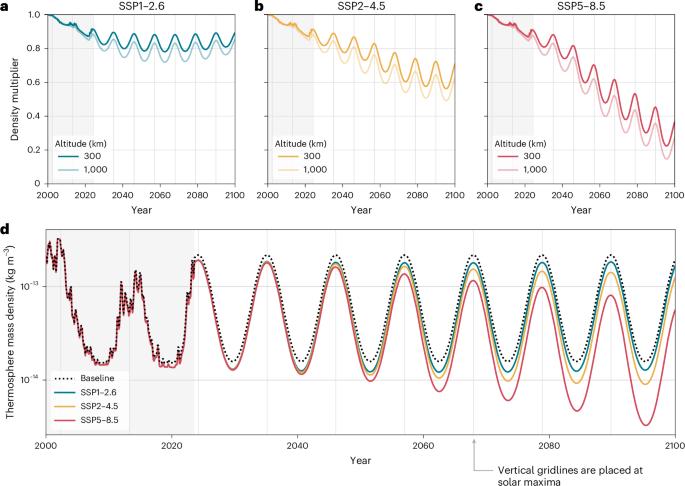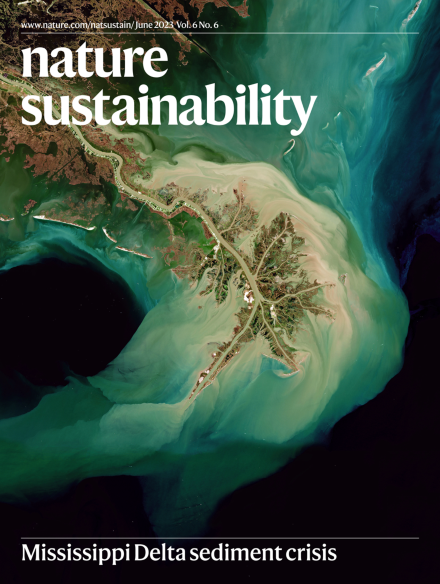温室气体降低了近地轨道卫星的运载能力
IF 27.1
1区 环境科学与生态学
Q1 ENVIRONMENTAL SCIENCES
引用次数: 0
摘要
已观察到地球大气中人为温室气体的贡献导致热层冷却和收缩,预计这将持续数十年。这种收缩导致大气质量密度的长期减少,而大多数卫星在近地轨道上运行。密度的降低减少了碎片物体的阻力,延长了它们在轨道上的寿命,对其他卫星构成了持续的碰撞危险,并有可能产生更多碎片。本研究使用来自共享社会经济路径的预估二氧化碳排放来研究温室气体排放对近地轨道卫星承载能力的影响。引入瞬时Kessler容量来计算使碎片种群处于稳定平衡状态的特征卫星的最大数量和最优分布。2000-2100年模拟的二氧化碳排放情景表明,在200至1000公里高度之间,卫星运载能力可能减少50-66%。考虑到近地轨道卫星数量最近迅速增加,了解环境变化及其对可持续业务的影响对于防止对该区域的过度开发是必要的。卫星已成为我们日常生活中不可或缺的一部分,但空间碎片威胁着近地轨道空间的可持续性。温室气体使问题复杂化,导致失效卫星在轨道上停留的时间更长,并增加碰撞的风险。本文章由计算机程序翻译,如有差异,请以英文原文为准。

Greenhouse gases reduce the satellite carrying capacity of low Earth orbit
Anthropogenic contributions of greenhouse gases in Earth’s atmosphere have been observed to cause cooling and contraction in the thermosphere, which is projected to continue for many decades. This contraction results in a secular reduction in atmospheric mass density where most satellites operate in low Earth orbit. Decreasing density reduces drag on debris objects and extends their lifetime in orbit, posing a persistent collision hazard to other satellites and risking the cascading generation of more debris. This work uses projected CO2 emissions from the shared socio-economic pathways to investigate the impact of greenhouse gas emissions on the satellite carrying capacity of low Earth orbit. The instantaneous Kessler capacity is introduced to compute the maximum number and optimal distribution of characteristic satellites that keep debris populations in stable equilibrium. Modelled CO2 emissions scenarios from years 2000–2100 indicate a potential 50–66% reduction in satellite carrying capacity between the altitudes of 200 and 1,000 km. Considering the recent, rapid expansion in the number of satellites in low Earth orbit, understanding environmental variability and its impact on sustainable operations is necessary to prevent over-exploitation of the region. Satellites have become integral to our everyday life, but space debris threatens the sustainability of low Earth orbital space. Greenhouse gases are complicating the problem, leading to longer orbital retention of defunct satellites and increasing the risk of collision.
求助全文
通过发布文献求助,成功后即可免费获取论文全文。
去求助
来源期刊

Nature Sustainability
Energy-Renewable Energy, Sustainability and the Environment
CiteScore
41.90
自引率
1.10%
发文量
159
期刊介绍:
Nature Sustainability aims to facilitate cross-disciplinary dialogues and bring together research fields that contribute to understanding how we organize our lives in a finite world and the impacts of our actions.
Nature Sustainability will not only publish fundamental research but also significant investigations into policies and solutions for ensuring human well-being now and in the future.Its ultimate goal is to address the greatest challenges of our time.
 求助内容:
求助内容: 应助结果提醒方式:
应助结果提醒方式:


